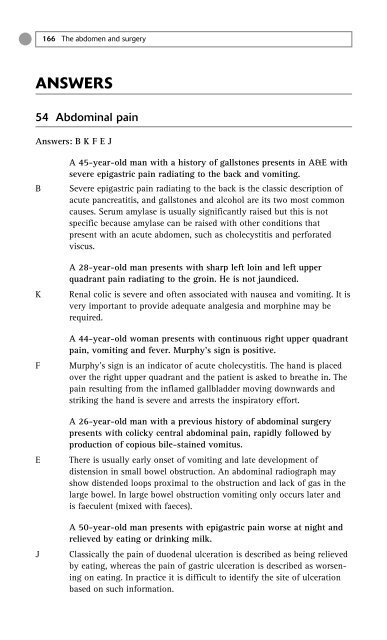EMQs in Clinical Medicine.pdf - Peshawar Medical College
EMQs in Clinical Medicine.pdf - Peshawar Medical College
EMQs in Clinical Medicine.pdf - Peshawar Medical College
Create successful ePaper yourself
Turn your PDF publications into a flip-book with our unique Google optimized e-Paper software.
166 The abdomen and surgery<br />
ANSWERS<br />
54 Abdom<strong>in</strong>al pa<strong>in</strong><br />
Answers: B K F E J<br />
B<br />
K<br />
F<br />
E<br />
J<br />
A 45-year-old man with a history of gallstones presents <strong>in</strong> A&E with<br />
severe epigastric pa<strong>in</strong> radiat<strong>in</strong>g to the back and vomit<strong>in</strong>g.<br />
Severe epigastric pa<strong>in</strong> radiat<strong>in</strong>g to the back is the classic description of<br />
acute pancreatitis, and gallstones and alcohol are its two most common<br />
causes. Serum amylase is usually significantly raised but this is not<br />
specific because amylase can be raised with other conditions that<br />
present with an acute abdomen, such as cholecystitis and perforated<br />
viscus.<br />
A 28-year-old man presents with sharp left lo<strong>in</strong> and left upper<br />
quadrant pa<strong>in</strong> radiat<strong>in</strong>g to the gro<strong>in</strong>. He is not jaundiced.<br />
Renal colic is severe and often associated with nausea and vomit<strong>in</strong>g. It is<br />
very important to provide adequate analgesia and morph<strong>in</strong>e may be<br />
required.<br />
A 44-year-old woman presents with cont<strong>in</strong>uous right upper quadrant<br />
pa<strong>in</strong>, vomit<strong>in</strong>g and fever. Murphy’s sign is positive.<br />
Murphy’s sign is an <strong>in</strong>dicator of acute cholecystitis. The hand is placed<br />
over the right upper quadrant and the patient is asked to breathe <strong>in</strong>. The<br />
pa<strong>in</strong> result<strong>in</strong>g from the <strong>in</strong>flamed gallbladder mov<strong>in</strong>g downwards and<br />
strik<strong>in</strong>g the hand is severe and arrests the <strong>in</strong>spiratory effort.<br />
A 26-year-old man with a previous history of abdom<strong>in</strong>al surgery<br />
presents with colicky central abdom<strong>in</strong>al pa<strong>in</strong>, rapidly followed by<br />
production of copious bile-sta<strong>in</strong>ed vomitus.<br />
There is usually early onset of vomit<strong>in</strong>g and late development of<br />
distension <strong>in</strong> small bowel obstruction. An abdom<strong>in</strong>al radiograph may<br />
show distended loops proximal to the obstruction and lack of gas <strong>in</strong> the<br />
large bowel. In large bowel obstruction vomit<strong>in</strong>g only occurs later and<br />
is faeculent (mixed with faeces).<br />
A 50-year-old man presents with epigastric pa<strong>in</strong> worse at night and<br />
relieved by eat<strong>in</strong>g or dr<strong>in</strong>k<strong>in</strong>g milk.<br />
Classically the pa<strong>in</strong> of duodenal ulceration is described as be<strong>in</strong>g relieved<br />
by eat<strong>in</strong>g, whereas the pa<strong>in</strong> of gastric ulceration is described as worsen<strong>in</strong>g<br />
on eat<strong>in</strong>g. In practice it is difficult to identify the site of ulceration<br />
based on such <strong>in</strong>formation.












